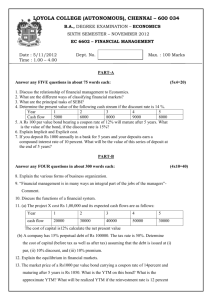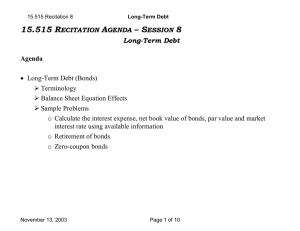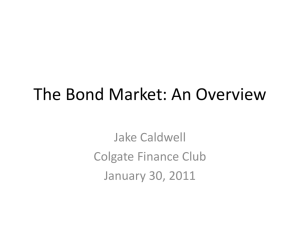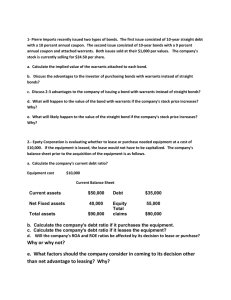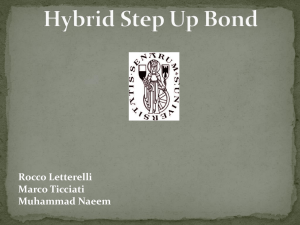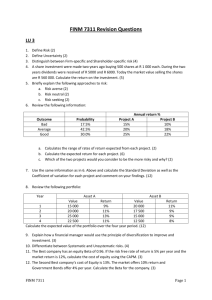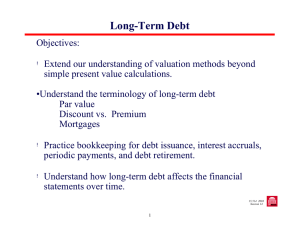Document 10280674
advertisement
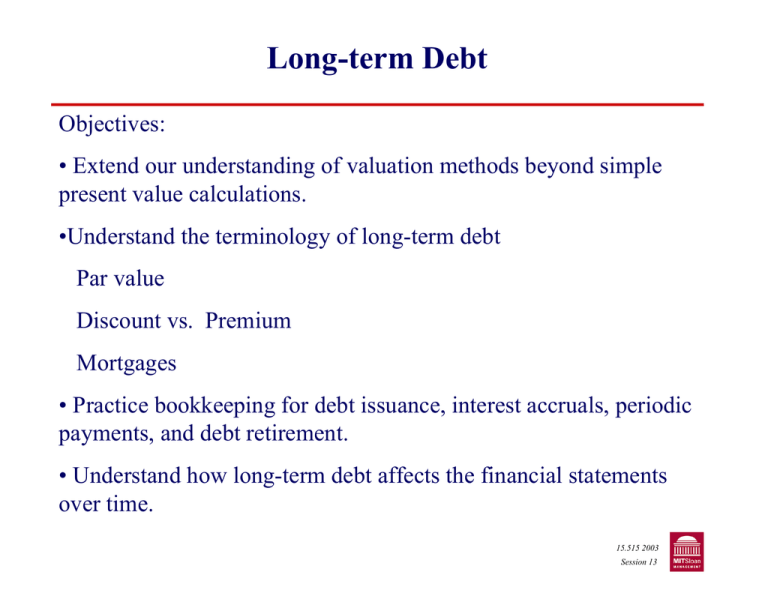
Long-term Debt Objectives: • Extend our understanding of valuation methods beyond simple present value calculations. •Understand the terminology of long-term debt Par value Discount vs. Premium Mortgages • Practice bookkeeping for debt issuance, interest accruals, periodic payments, and debt retirement. • Understand how long-term debt affects the financial statements over time. 15.515 2003 Session 13 Bonds – Terminology Par value - stated or face value of the bond; the amount due at maturity Market value - the value assigned to the bond by investors Three interest rates are relevant to bond accounting: 1) Coupon rate - the rate used to determine the periodic cash payments (if any) 2) (Current) Market interest rate - the rate used to determine the current market value of the bond. The market rate is based upon market conditions and the risk characteristics of the borrower 3) Effective interest rate - the market rate at issuance, used to determine the interest expense and the book value of the liability 15.515 2003 Session 13 Bonds – An Introduction If at issuance the market rate = coupon rate then market value = par value. The bond is said to sell at par (also, face value). When a bond sells at par its coupon payment is equal to its interest expense. While we will primarily focus on bonds sold at par, there are two other possibilities: If at issuance the market rate is greater than the coupon rate then the market value is less than par value. The difference between market value and par value is called the discount on the bond and its coupon payment is less than its interest expense. An extreme case of this is the zero-coupon bond. If at issuance the market rate is less than the coupon rate then the market value is greater than the par value. The difference between market value and par value is called the premium on the bond and its coupon payment is more than its interest expense. 15.515 2003 Session 13 Bonds Consider a loan with proceeds of $10,000 initiated on 1/1/99. The market interest rate is 6% and final payment is to be made at the end of the third year (12/31/01). What annual payments are required under the following three alternatives? I. Yearly payments of interest at the end of each year and repayment of principal at the end of the third year (typical bond terms). II. Three equal payments at the end of each year (mortgage / new car loan terms). III. A single payment of principal and interest at the end of year 3 (Zero-Coupon bond). 15.515 2003 Session 13 Bonds – Alternative Payment Streams I coupon II mortgage III zero End of Year 1 End of Year 2 End of Year 3 Undiscounted sum of payments 15.515 2003 Session 13 Bonds – Financial Statement Presentation Balance sheet L-T debt due in next 12 months in current liabilities remainder of L-T debt in non current liabilities. Income Statement interest expense Indirect SCF Operations – add interest accruals not yet paid, amortization of discount Investing - purchase / sale of debt held as an investment Financing – proceeds from issuance, payments for retirement + supplemental disclosure of cash paid for interest Notes details on all of the above 15.515 2003 Session 13 Summary • Long-term liabilities such as bonds are reported at PV • Discount rate for PV calculation = market rate at time of issuance (= effective int. rate) • Debt characteristics vary widely – we looked at 3 types. • Interest payments ≠ interest expense if coupon rate ≠ effective interest rate • Market value may substantially differ from reported book value of debt if market rate changes significantly after issuance. 15.515 2003 Session 13
